 There are three plants which usually arise and bloom in late winter and early spring. They tend to be confused in their identification since the flowers are similar in color, the leaves seem to be the same shape and size, and the height of the plants are nearly the same. Let’s look closely at each of these three plants and see how they are different — to make their identification more certain when you next encounter them.
There are three plants which usually arise and bloom in late winter and early spring. They tend to be confused in their identification since the flowers are similar in color, the leaves seem to be the same shape and size, and the height of the plants are nearly the same. Let’s look closely at each of these three plants and see how they are different — to make their identification more certain when you next encounter them.
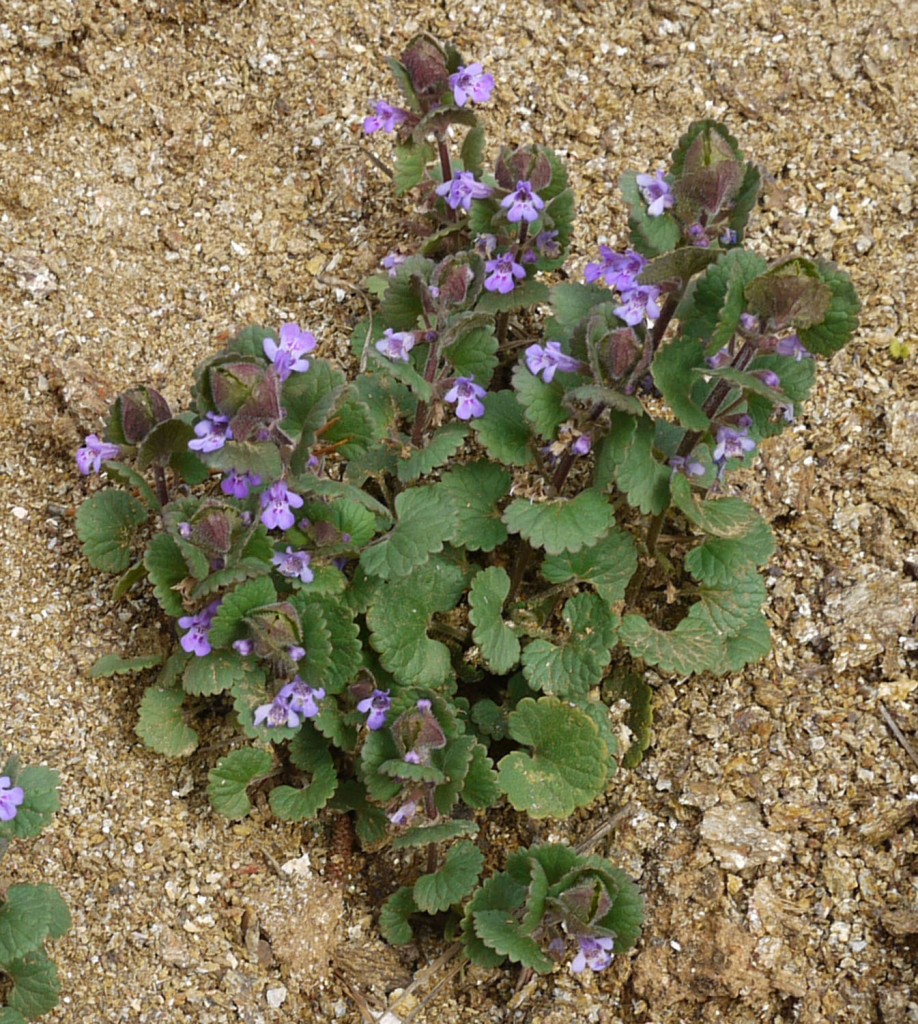 Starting with Ground ivy (Glechoma hederacea) . . . This plant has many common names. Some other popular ones are Gill-over-the-ground and Creeping Charlie. All three common names hint at this plant’s growth habit: low and sprawling like ivy.
Starting with Ground ivy (Glechoma hederacea) . . . This plant has many common names. Some other popular ones are Gill-over-the-ground and Creeping Charlie. All three common names hint at this plant’s growth habit: low and sprawling like ivy.
 The leaf shape is round and is sometimes classified as nearly kidney-shaped. The leaf edges are “scalloped” or “bluntly toothed.” The veins are noticeable and mostly palmate.
The leaf shape is round and is sometimes classified as nearly kidney-shaped. The leaf edges are “scalloped” or “bluntly toothed.” The veins are noticeable and mostly palmate.
 In the next photo you can see some older yellowing leaves. Also noticeable are the hairs on the leaves. The stalked leaves grow opposite each other along the stem. If you bruise the stem or the leaves, you will detect a strong aroma. Ground ivy is a member of the Lamiaceae (Mint) family.
In the next photo you can see some older yellowing leaves. Also noticeable are the hairs on the leaves. The stalked leaves grow opposite each other along the stem. If you bruise the stem or the leaves, you will detect a strong aroma. Ground ivy is a member of the Lamiaceae (Mint) family.
 Let’s look at the Ground ivy flower. It is bilateral (or irregular) in shape — with lower and upper petal lips. (In this photo, the white areas on the petals are actually water drops.)
Let’s look at the Ground ivy flower. It is bilateral (or irregular) in shape — with lower and upper petal lips. (In this photo, the white areas on the petals are actually water drops.)
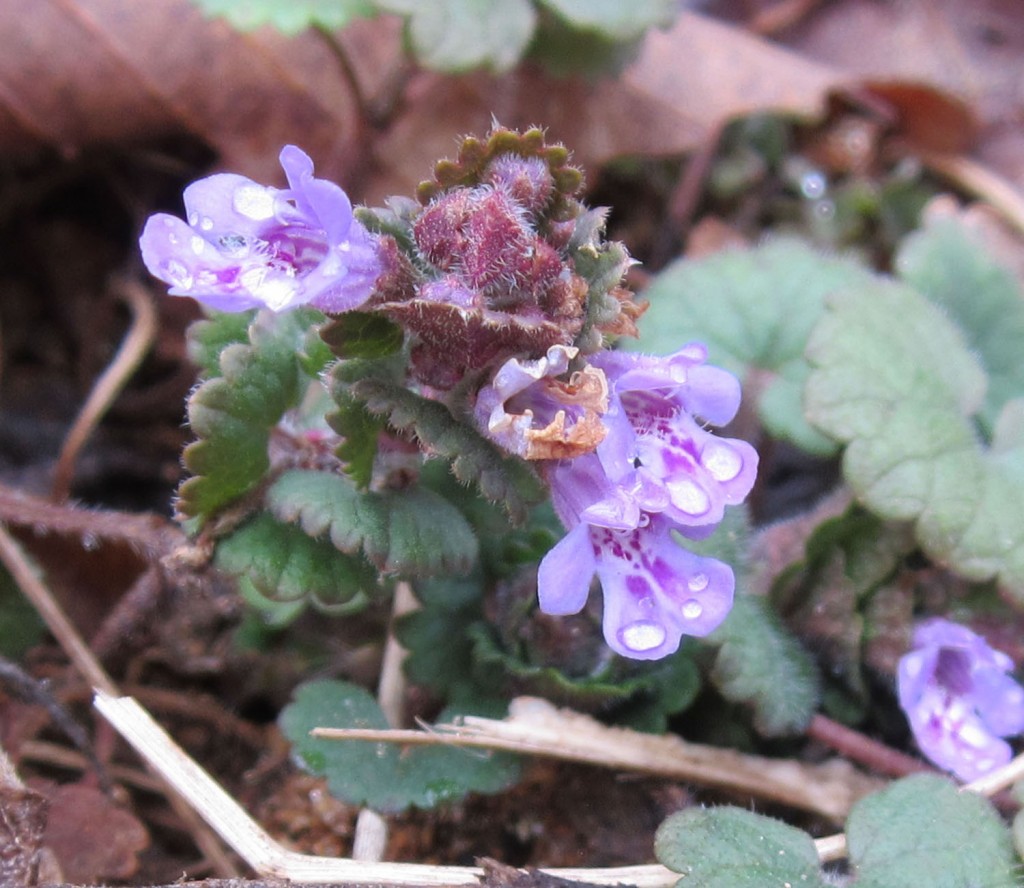 Here’s another image of the Ground ivy flower. The flowers grow in whorls from the plant’s stem.
Here’s another image of the Ground ivy flower. The flowers grow in whorls from the plant’s stem.
 The second plant is another hairy one — which can be mistakenly identified as Ground ivy. This is Purple dead nettle (Lamium purpureum).
The second plant is another hairy one — which can be mistakenly identified as Ground ivy. This is Purple dead nettle (Lamium purpureum).
 How can Purple dead nettle be distinguished from Ground ivy? First, let’s look more closely at the leaves.
How can Purple dead nettle be distinguished from Ground ivy? First, let’s look more closely at the leaves.
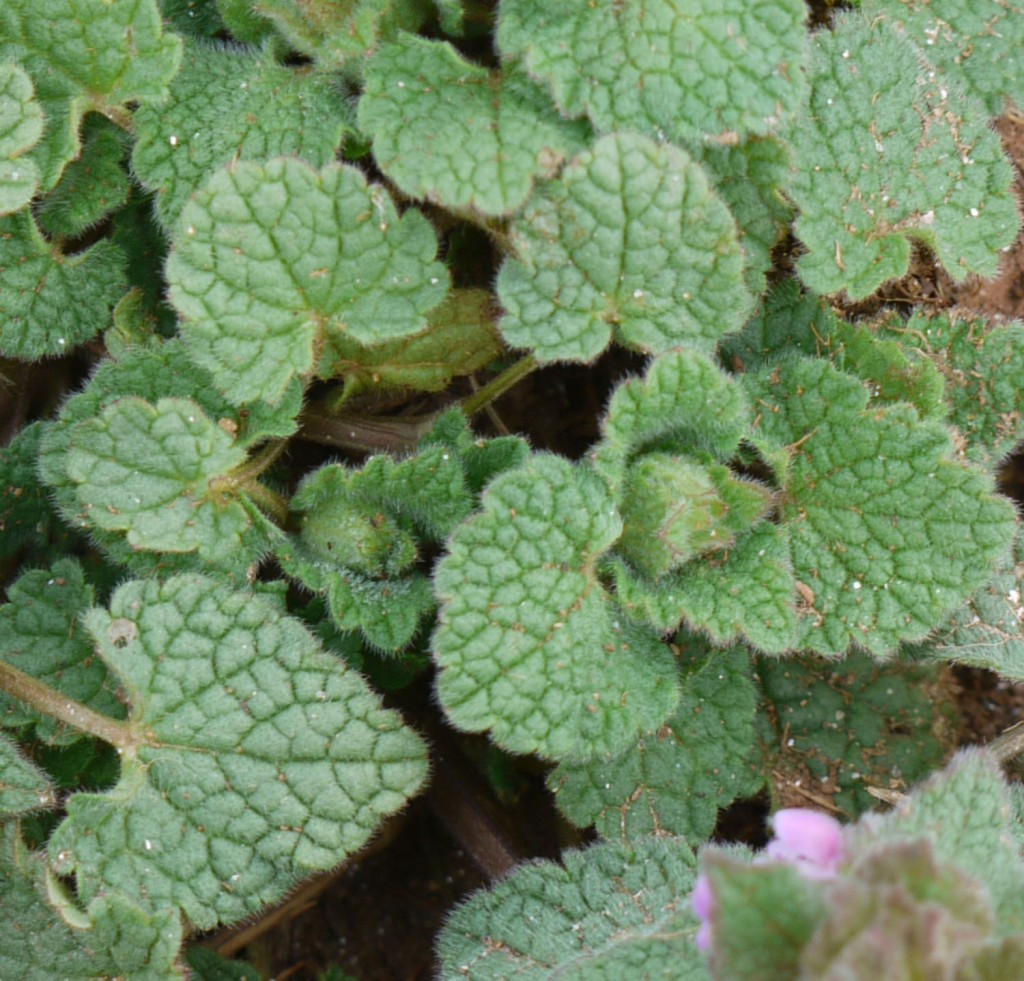 Although the venation looks almost the same, the leaf shape is more like a heart — less rounded and more pointed at the tip. Also, Purple dead nettle’s leaf margins are not as deeply scalloped as Ground ivy’s margins. Both plants’ leaves have stems.
Although the venation looks almost the same, the leaf shape is more like a heart — less rounded and more pointed at the tip. Also, Purple dead nettle’s leaf margins are not as deeply scalloped as Ground ivy’s margins. Both plants’ leaves have stems.
Looking at the leaves at the top of a plant . . .
 . . . not only are they covered with hair, they also change color — to lavender — or even a purple shade. The leaves are arranged oppositely along the stem. The next photo provides a close look at the Purple dead nettle flowers. (Notice the upper leaves’ deeper shade of purple — or red.)
. . . not only are they covered with hair, they also change color — to lavender — or even a purple shade. The leaves are arranged oppositely along the stem. The next photo provides a close look at the Purple dead nettle flowers. (Notice the upper leaves’ deeper shade of purple — or red.)
 Similar to the Ground ivy flowers, these bilateral flowers have lips. However, the lip structure is different. You may want to scroll up and down this post to compare the two flowers more carefully.
Similar to the Ground ivy flowers, these bilateral flowers have lips. However, the lip structure is different. You may want to scroll up and down this post to compare the two flowers more carefully.
Purple dead nettle is also in the Lamiaceae (Mint) family. You can clearly see the square stem in the next image.
 For our third “looks similar” plant, we turn to another member of the Lamiaceae family.
For our third “looks similar” plant, we turn to another member of the Lamiaceae family.
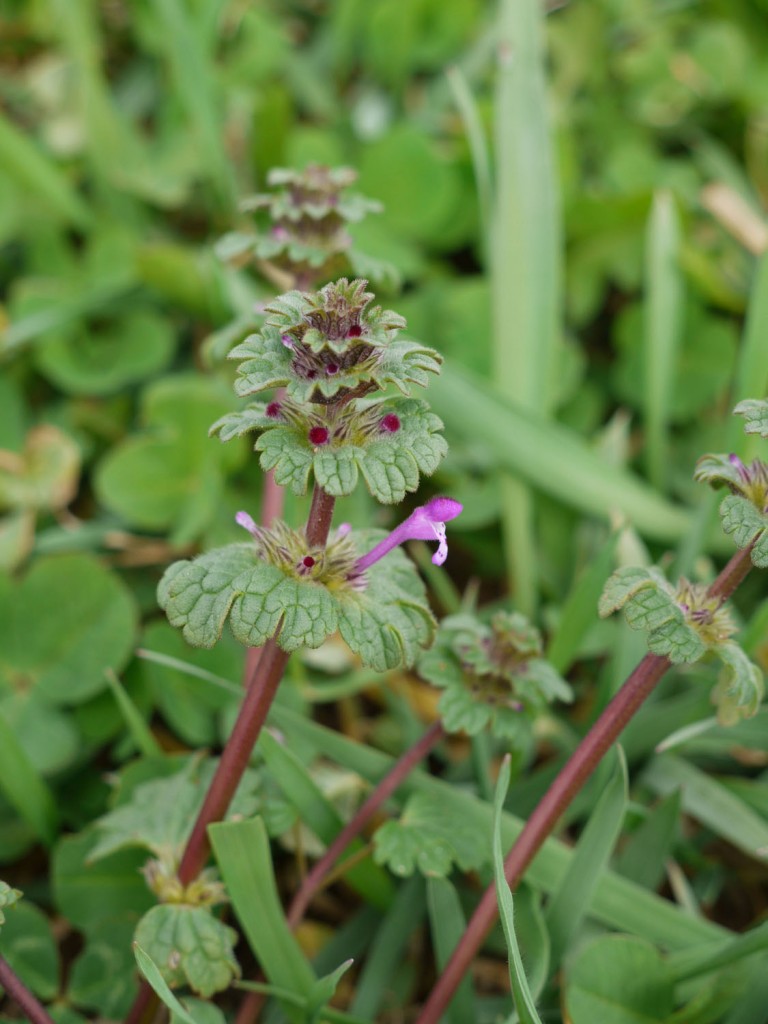 This is Henbit (Lamium amplexicaule). One of Henbit’s striking features is the stem color — a nice deep red throughout the length of the stem. The stem is also square. There are lengths of stalk visible between the sets of leaves.
This is Henbit (Lamium amplexicaule). One of Henbit’s striking features is the stem color — a nice deep red throughout the length of the stem. The stem is also square. There are lengths of stalk visible between the sets of leaves.
So how are Henbit’s leaves different from either Ground ivy or Purple dead nettle leaves?
 The most significant difference is that Henbit leaves are in whorls around the stem. They also are sessile — without any little stems of their own. The leaf margins are deeply scalloped — far more than Ground ivy’s leaf margins. And . . . the leaves do not have hairs at all. Instead they look more glossy.
The most significant difference is that Henbit leaves are in whorls around the stem. They also are sessile — without any little stems of their own. The leaf margins are deeply scalloped — far more than Ground ivy’s leaf margins. And . . . the leaves do not have hairs at all. Instead they look more glossy.
A closer look at the Henbit flowers reveals they, too, are arranged in whorls around the stem. This is most noticeable in the above image — where the flowers are still in bud.
 Henbit’s flower shape is remarkably similar to Purple dead nettle’s flower shape. This makes sense as they are both in the same genus (Lamium). However, there is one obvious difference between the two flowers.
Henbit’s flower shape is remarkably similar to Purple dead nettle’s flower shape. This makes sense as they are both in the same genus (Lamium). However, there is one obvious difference between the two flowers.
 Henbit’s flower has a long tube portion which is clearly visible when the flower is fully open.
Henbit’s flower has a long tube portion which is clearly visible when the flower is fully open.
And just to keep you challenged — these three plants love to intermingle. Which plants can you pick out and identify from these last two images?


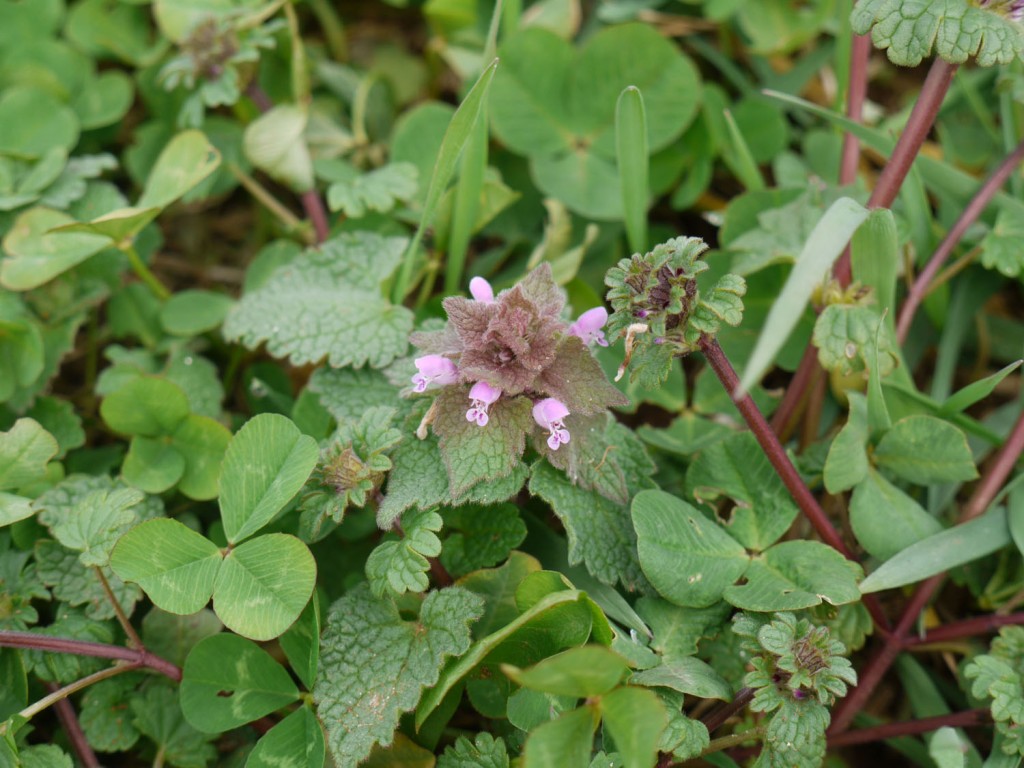
Very good photos but one point: You say that “Here’s another image of the Ground ivy flower. The flowers grow in whorls from the plant’s stem.” I always thought and have observed that it’s two flowers for each leaf pair and that is not a whorl. Please advise. Thanks, Michael DeMarco
Good question, Michael. I checked a few different sites (miles apart) which have Ground ivy. I noticed that some plants have only two blossoms at each pair of leaves while others have a whorl of anywhere from three to six or so flowers. There may be only two flowers blooming at a time. Yet, with the whorls, some are in bloom, some are buds, some have flowered. Another example of plant variation!
Angelyn, Thanks for the rapid response. Right after I sent the comment the thought “variation” popped into my head. 🙂
And I will be checking closer myself!
Here in central Kentucky, I must have all three growing together. My yard was once a pasture. I have been harvesting what I thought was henbit. Now I see it is dead-nettles, both of which are edible. Ground ivy grows here as well. This is the first website that compares them and shows the differences with such clear photos. Thank you for that. Looking at just one at a time a person might think they are the same. I would like to see them compared to another, similar plant that I think is a speedwell but it’s flowers are blue and white.
Robin, thanks for your suggestion about comparing these with a speedwell. I am adding that to my list of potential blog posts!
Great pictures and good descriptions. The question is, are they all invasive weeds. I have ground ivy taking over my yard and recall reading that it was nearly impossible to get rid of. I’m not sure about the others.
Yes, Betsy, each of these three is considered a “weed” by most people. A positive point of view is that they make an excellent ground cover for bare ground!
They are all extremely nutritious also and pretty much grow all around the world. There is a new branch of herbology called Invasive Plant Medicine…many of our “weeds” are actually very healing and contain nutrients needed by our bodies. I try to strike a balance of growing some where I can scissor cut them for meals or pull them out in my garden beds.
that many are medicinal makes sense to me. Herbalists may have brought them here for that reason.
I love ground ivy as a ground cover! Its fragrance brings back memories of my dad cutting our back yard, and that wonderful smell as he got into the “weeds” at the very back. I also note that its root system is pretty shallow, and so I don’t mind it taking over from the bishop weed currently in my back yard. The latter has a very deep root system, and is way harder to get rid of where you don’t want it.
Thank you..thank you..thank you! I have recently started to study wild herbs and edibles…and your comparisons have helped tremendously!
Wonderful site! Will check for other mystery plants out and about. Thanks for the info.
I have been going crazy trying to identify these purple wildflowers in my yard and since I read that ground ivy is a medicinal plant I made a tea from it and tried it. Not unlike liquid chlorophyll and I presumed it is beneficial as well. Imagine my surprise when my daughter pointed out that those plants are not alike. So coming to your website, it was clearly explained, and I am anxious to find out what the purple dead nettle and henbit are good for beside just forage for animals. Thanks for your presentation. Oh, BTW, I do like Euell Gibbons. I guess that’s why I try to eat natural plants.
Wonderful site — so helpful! As it turns out I have all three growing in my backyard –what a delight to find this out.
Thanks!
the ground ivy in our 2.5 acre lawn has completely taken over. How do you get rid of it???
I’m sure there are chemical means of doing this although I personally don’t use chemicals. Instead, I hand-pull the plants and try to get the roots as much as possible (usually after a soaking rain). It does take a persistent effort to eliminate a plant this way.
Try pigs. They root all sorts of things out.
Why would you want to get rid of it? Clearly, it is a blessing.
Mix Borax and water and spray. Yes, you can use 20 Mule Team Borax.
We also had our lawn/garden taken over by ground ivy. We have tried every possible remedy. I am allergic to the smell when my husband mows, so we really need to get rid of the weed. I found it interesting that it is a member of the mint family. Should have known. 🙁
We have been battling our neighbor’s uncontrolled Creepin’ Charlie for years. Finally won some measure of control with a strong borax mixture, applied two to three times per year. Neighbor unfortunately still provides lots more of both Ground Ivy as well as Dandelions- he thingk they’re pretty! (Plus he hates yard work!) This year they are back, but not in such quantities- yet, so out comes the Borax!
“Weeds” are in the eye of the beholder… any plant that is where you don’t want it is generally considered a weed. I personally do not consider exible & medicinal plants to be weeds. I encourage their growth (including dandelions) in my yard🙂
I agree. Also, although I have these 3 plants in abundance in my spring garden, they are easy to pull and to plant around and do not seem to impede the growth of other plants. They are more like living mulch, suppressing the grasses which ARE an issue.
I saw and enjoyed this post several months ago, but it’s also been useful recently when I was mowing through a bunch of aromatic, purple-flowering ground cover and wondered what it was. So apparently, we have a *lot* of ground ivy, but it’s so pretty and so sweetly-scented, I’m thinking of trying to transplant it to other areas that could use a consistent ground cover. Maybe it is a weed, but I think it’d be an improvement over the dirt/noxious weeds in some areas. Do you know anything about the ideal habitat? My current batch gets some morning and midday sun, but afternoon shade and a fair bit of moisture. It was growing fairly high when I got around to mowing it.
Like any good “weed,” Ground ivy is pretty hardy. I’ve seen it growing in dry and sunny locations as well as shadier and moister spots.
My goal is to have the Ground Ivy completely take over and drive out the useless grass. The Ground Ivy is beautiful, it blooms all summer long, it doesn’t grow much higher than ankle high, and if you want to mow it, it releases a delightful minty fragrance. Its analgesic leaves are useful to molting birds, who roll in it to relieve the pain of their feathers poking though their skin, and the Ground Ivy also helps to prevent infection because of its antiseptic property.
Wow, that’s great info.
You’re my hero. The Ground Ivy now covers about 80% of my yard, and I’ve decided to just go with it. I have some of the nettle popping up too, but I just hate it. It’s easy to dig up, so I do.
Jacqueline Donnelly, Creeping Charlie is also a flea & tick repellent: )
PFAF (Plants for a Future) is a massive resource https://pfaf.org/user/Plant.aspx?LatinName=Glechoma+hederacea
This is great, thank you! I always have to look at these three closely to be sure I know which one I am getting.
Pingback: A Druid’s web log – Spring is coming! Don’t forget to vote on March 1! | Ellen Evert Hopman
thanks but when you pick out one of the petals from the henbit, the white end tastes like sugar! good or bad?
A weed is just a plant growing where YOU don’t want it.
So true. In reality, there are no weeds. There may be quite a few plants that we think of as harmful though. I’m thinking of things such as chola cactus out west (jumping cactus) which can really hurt. Also, stinging nettles, although if handled properly, have medicinal value. The manchaneel tree in the Florida swamps secretes a burning acid and I have never heard of there is a beneficial use for it.
It has disturbed me ever since I was just three years old, that people consider plantain, dandelion and lamb’s quarters to be weeds. I new instinctively that these were beneficial.
Dear Angelyn,
What a terrific post. Thank you!!!
I was hoping though, for information about uses for each individual plant.
For instance: tea from dried or fresh? Salad ingredients, garnish? Freeze dried for cake decor? I’m just making wild guesses here.
There is a nice web site which has in depth info about various edible weeds, including how to use them. eattheweeds.com
Wonderful photos! Wonderful descriptions! Wonderful web site–just what I needed!
Laurie in Winston-Salem, North Carolina
So which ones edible?
They all are edible – in moderation. Suggested site for details: eattheweeds.com
Really nice pictures! What kind of camera do you use? I have a love/hate relationship with ground ivy. It is beautiful but gets all in my herb raised beds – yes, raised beds! It creeps up under the sides and is usually fairly established by the time it appears on top of the ground. Sometimes I think I’ll just let it take over my shady backyard – it smells good when it’s mowed.
As a child my siblings and I played with henbit and purple dead nettle. We never knew their names though, and made up our own name, Christmas tree flowers. While we did recognise that there were two different kinds of christmas tree flowers, we did not give them different names. It is nice to finally know what the rest of the world calls them.
I love your idea! Thank you for sharing such useful information!
This was supposed to be a reply to Jaqueline Donnelly.
Thanks for this post, Ive taken an interest in plants recently and was curious about the similarities in these 3. In my yard the purple dead nettle is EVERYWHERE and the other two are only in a few small patches.. is there anyway I can make the ground ivy spread?
Pingback: A Druid’s Web Log – Beltaine (May Day) 2016 | Ellen Evert Hopman
Lovely site, Angelyn & thank you so much for the info on ground ivy! I have it all through the backyard & love how it looks, but never knew the name. To find out that it’s called “Gill-over-the-ground” just tickled me because my maiden name is Gill! Another tick on the “meant-to-be” chart of buying an old house & inheriting (& usually correcting) almost a century’s worth of previous owners’ landscaping & remodeling choices. Much appreciated!
very very helpful-thank you!
Pingback: If You Need It… — Grandparents of the Forest
I also have ground ivy all over my yard and this year I noticed the honey bees were all over it, so there’s one more reason to let it grow! =)
Thanks for these great photos and notes on distinguishing these three plants. I’m putting a link on my blog to send people here to learn.
Pingback: Heritage Harvest Festival soon! meanwhile in the garden . . . | Sustainable Market Farming
This is a great article. Thanks for clear ID detail.
John
Excellent information on easily confused plants! Thanks so much!
Ground Ivy is edible.
http://www.eattheweeds.com/ground-ivy/
Thanks for the article!
Gill over the ground comes from the French, gilleur, to ferment, as it was used in fermenting beer in the middle ages…
These are growing next to one another in my yard. I really appreciate the update with the photos. I confuse easily. It’s good to know they are edible. Now I can warn them I will not only tear them out but I will eat them if they do not leave immediately.
Thanks for the great information and photos. I was recently traveling through Virginia on Rt 81 and noticed the purple flowers in the fields and with the information that you have provided I believe I may know what I was observing at 65-70MPH.
Love this post! Thank you!!! I am in the process of identifying all the “weeds” in my yard so that I can cultivate the useful/pretty natives and get rid of the grass and non-native invasives. I definitely have all three of these but hadn’t yet distinguished between the deadnettle and henbit. Do you have any other advice for weed ID resources? Thanks again!
I live in my parents’ old house, and I have Creeping Charlie (Ground Ivy) all over my back yard and one side yard. I also have multiple sclerosis, so yard work, other than mowing, is more than I can handle. I can remember my dad spending a lot of hours trying to keep the Creeping Charlie out of the yard, but it has moved in to stay since Dad passed. Like most of the others here, I actually don’t mind it at all. It doesn’t look bad, and it keeps the grass down to a manageable level. And the odor when you mow it is very pleasant… to me anyway. I didn’t realize that it was a member of the mint family, but that does make sense. 🙂 I also have some Purple dead nettle and Henbit that shows up in the field next to my house, although I didn’t know what to call them before now.
And, then there’s prunella…
Before anyone goes out and starts gorging on these or any wild plant, PLEASE educate yourself about them.
Here’s a page with info on the side effects of Ground Ivy.
http://www.webmd.com/vitamins-supplements/ingredientmono-26-ground%20ivy.aspx?activeingredientid=26&activeingredientname=ground%20ivy
I thought my lawn care company was failing to get rid of this plant. Now I see that I need to pick it, which is what I did for a couple hours one day. I’ll keep after it now, and may transplant some of it to an area where it can be just a ground cover. I’ll monitor its movement, though.
I will say that ground ivy also grows like a madman, at least in my experience. Ground ivy is also the one that smells most like mint (at least the varieties in the Virginia area), though i have heard that it is at least a little bit poisonous to some animals/insects. I haven’t eaten henbit or heard of purple deadnettle before either. I always thought they were the nettles that Eeyore ate in Winnie the Pooh.
There was a reason i signed up for the weekly newsletter, haha.
Pingback: A Druid's Web Log - Beltaine (May Day) 2016 - Ellen Evert Hopman
Pingback: A Druid's web log - Spring is coming! Don't forget to vote on March 1! - Ellen Evert Hopman
I, too, really appreciate the clear pictures and descriptions. And just as much, I am loving the enjoyable comments and so many sweet reminiscences of these plants!
My lawn has a lot of ground ivy which grows into the flower beds. If I try the Borax mix, will it kill the grass in the lawn?
I would consider that it will kill bees and possibly other beneficial insects you may have. Removal by hand or placing dampened newspapers on top of them, weighed down with stones/bricks etc., on corners, works well.
Newspapers may be hard to come by though. I saw a material at the hardware store that should work the same way.
I’ve had “creeping charlie” in my yard before, and used it for hanging baskets; which were really pretty, as it grows downward a long way, and blooms. Now I’m going to try this with the henbit.
Also looking into medicinal uses of the herbs and “weeds” growing around the property.
Really good clear information, thank you!
Glad I found this old post. My yard, it seems, gets more and more of these “weeds” and I’ve always wondered what they were. I do enjoy the “minty” smell of the ground ivy. I might just leave them be and let my yard be taken over by them. The only problem is that I have a good mess of crabgrass and I believe, chickweed. I really don’t like the chickweed.
One of my favorite foods is chickweed pesto — made with Common chickweed (Stellaria media).
Thank you for keeping this post alive, very helpful. I’m still working out the difference between henbit and mazus, I have both. 🤔
This is very helpful! I’m studying for a plant ID test and you just made my life a LOT easier!! Thanks!
It’s also a flea & tick repellent: )
For those looking for plant ID and uses for Creeping Charlie/Gill-Over-the-Ground, Henbit,etc; this site is a massive source: https://pfaf.org/user/Plant.aspx?LatinName=Glechoma+hederacea
Thanks for the wonderful photos and a great article Angelyn (and to your readers for all of these fabulous comments!: )
Pingback: Henbit, Violet, Deadnettle and other small purple flowers… | Arts & Wildcraft blog
Pingback: 9+ Things to Make with Purple Dead Nettle
Is your “ground ivy” also called dwarf Kenilworth ivy? It looks very similar, I have the dwarf Kenilworth ivy growing all over my yard, shallow rooted, easy to pull, but impossible to be permanently rid of grows like crazy takes over in amatter of a couple weeks.
Pingback: Red Deadnettle – The Philadelphia Nature Guide
Pingback: Ground-Ivy – The Philadelphia Nature Guide
Pingback: Creeping Charlie Uses ~ An Overlooked Edible & Medicinal Herb
Pingback: Creeping Charlie Look Alikes {Ground Ivy Identification}
Pingback: Weeds of the Month for October: Winter Annuals – Sustainable Market Farming